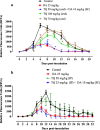Evaluation of the in vitro and in vivo inhibitory effect of thymoquinone on piroplasm parasites
- PMID: 30651142
- PMCID: PMC6335684
- DOI: 10.1186/s13071-019-3296-z
Evaluation of the in vitro and in vivo inhibitory effect of thymoquinone on piroplasm parasites
Abstract
Background: Developing new antibabesial drugs with a low toxic effect to the animal and with no resistance from Babesia parasites is in urgent demand. In this concern, the antimalarial, anticancer and antioxidant effect of thymoquinone (TQ), a phytochemical compound found in the plant Nigella sativa, has been reported. Therefore, in the present study, the antibabesial effect of this compound was evaluated on the growth of piroplasm parasites.
Results: Significant inhibition (P < 0.05) of the in vitro growth of piroplasm parasites were observed after treatment by TQ with IC50 values of 35.41 ± 3.60, 7.35 ± 0.17, 0.28 ± 0.016, 74.05 ± 4.55 and 67.33 ± 0.94 μM for Babesia bovis, Babesia bigemina, Babesia divergens, Theileria equi and Babesia caballi, respectively. The in vitro inhibitory effect of TQ was significantly enhanced (P < 0.05) when used in combination with either diminazene aceturate on bovine Babesia and equine Babesia and Theileria cultures. In B. microti-infected mice, oral and intraperitoneal administrations of TQ showed significant (P < 0.05) inhibition of parasite growth at a dose of 70 mg/kg and 50 mg/kg, respectively, compared to the control group.
Conclusions: The obtained results indicate that thymoquinone might be a promising medicinal compound for use in the treatment of animal piroplasmosis.
Keywords: Babesia; In vitro; In vivo; Theileria; Thymoquinone.
Conflict of interest statement
Ethics approval and consent to participate
All experimental protocols in this study were approved by the Animal Care and Use Committee, Obihiro University of Agriculture and Veterinary Medicine (approval no. 27–65).
Consent for publication
Not applicable.
Competing interests
The authors declare that they have no competing interests.
Publisher’s Note
Springer Nature remains neutral with regard to jurisdictional claims in published maps and institutional affiliations.
Figures


Similar articles
-
17-DMAG inhibits the multiplication of several Babesia species and Theileria equi on in vitro cultures, and Babesia microti in mice.Int J Parasitol Drugs Drug Resist. 2018 Apr;8(1):104-111. doi: 10.1016/j.ijpddr.2018.02.005. Epub 2018 Mar 1. Int J Parasitol Drugs Drug Resist. 2018. PMID: 29499568 Free PMC article.
-
The effects of trans-chalcone and chalcone 4 hydrate on the growth of Babesia and Theileria.PLoS Negl Trop Dis. 2019 May 24;13(5):e0007030. doi: 10.1371/journal.pntd.0007030. eCollection 2019 May. PLoS Negl Trop Dis. 2019. PMID: 31125333 Free PMC article.
-
Ellagic acid microspheres restrict the growth of Babesia and Theileria in vitro and Babesia microti in vivo.Parasit Vectors. 2019 May 28;12(1):269. doi: 10.1186/s13071-019-3520-x. Parasit Vectors. 2019. PMID: 31138282 Free PMC article.
-
Discovering the in vitro potent inhibitors against Babesia and Theileria parasites by repurposing the Malaria Box: A review.Vet Parasitol. 2019 Oct;274:108895. doi: 10.1016/j.vetpar.2019.07.003. Epub 2019 Jul 19. Vet Parasitol. 2019. PMID: 31494399 Review.
-
Equine piroplasmosis.Vet Clin North Am Equine Pract. 2014 Dec;30(3):677-93. doi: 10.1016/j.cveq.2014.08.008. Epub 2014 Oct 6. Vet Clin North Am Equine Pract. 2014. PMID: 25300637 Review.
Cited by
-
In vivo activity and atom pair fingerprint analysis of MMV665941 against the apicomplexan parasite Babesia microti, the causative agent of babesiosis in humans and rodents.Pathog Glob Health. 2023 May;117(3):315-321. doi: 10.1080/20477724.2022.2128571. Epub 2022 Sep 28. Pathog Glob Health. 2023. PMID: 36172647 Free PMC article.
-
Imidazo[1,2-a]pyridine: a Highly Potent Therapeutic Agent Clears Piroplasm Infection In Vitro.Acta Parasitol. 2023 Mar;68(1):249-256. doi: 10.1007/s11686-022-00655-w. Epub 2023 Jan 13. Acta Parasitol. 2023. PMID: 36637693
-
Compounds from the Medicines for Malaria Venture Box Inhibit In Vitro Growth of Babesia divergens, a Blood-Borne Parasite of Veterinary and Zoonotic Importance.Molecules. 2021 Nov 24;26(23):7118. doi: 10.3390/molecules26237118. Molecules. 2021. PMID: 34885700 Free PMC article.
-
Safety and efficacy of hydroxyurea and eflornithine against most blood parasites Babesia and Theileria.PLoS One. 2020 Feb 13;15(2):e0228996. doi: 10.1371/journal.pone.0228996. eCollection 2020. PLoS One. 2020. PMID: 32053698 Free PMC article.
-
Effect of methanolic extract from Capsicum annuum against the multiplication of several Babesia species and Theileria equi on in vitro cultures, and Babesia microti in mice.Vet World. 2022 Jan;15(1):76-82. doi: 10.14202/vetworld.2022.76-82. Epub 2022 Jan 20. Vet World. 2022. PMID: 35369597 Free PMC article.
References
-
- El-Sayed SAES, Rizk MA, Terkawi MA, Mousa A, El Said ESES, Elsayed G, et al. Cocktail of Theileria equi antigens for detecting infection in equines. Asian Pac J Trop Biomed. 2015;5:977–981. doi: 10.1016/j.apjtb.2015.09.001. - DOI
Publication types
MeSH terms
Substances
Grants and funding
LinkOut - more resources
Full Text Sources

